Identifying the Driving Impact Factors on Water Yield Service in Mountainous Areas of the Beijing-Tianjin-Hebei Region in China
Abstract
1. Introduction
2. Materials and Methods
2.1. Study Area
2.2. Annual Water Yield Simulation
2.3. Data Preparation and Processing
2.4. Scenario Settings and Contribution Analysis
3. Results
3.1. Spatio-Temporal Variation of Climate Change
3.2. Spatio-Temporal of Variation Land Use/Land Cover Change
3.3. Spatio-Temporal Change in Water Yield
3.4. Water Yield of Different Land Use/Land Cover
3.5. Contributions of Climate and LULC to Water Yield
4. Discussion
5. Conclusions
Author Contributions
Funding
Data Availability Statement
Conflicts of Interest
References
- Costanza, R.; Ralph, D.; Rudolf, D.G.; Stephen, F.; Monica, G.; Bruce, H.; Karin, L.; Shahid, N.; Robert, V.O.; Jose, P.; et al. The value of the world’s ecosystem services and natural capital. Nature 1997, 387, 253–260. [Google Scholar] [CrossRef]
- Millennium Ecosystem Assessment. Ecosystems and Human Well-Being: Synthesis; Island Press: Washington, DC, USA, 2005. [Google Scholar]
- Barral, M.P.; Rey Benayas, J.M.; Meli, P.; Maceira, N.O. Quantifying the impacts of ecological restoration on biodiversity and ecosystem services in agroecosystems: A global meta-analysis. Agric. Ecosyst. Ecosyst. Environ. 2015, 202, 223–231. [Google Scholar] [CrossRef]
- Han, R.; Feng, C.C.; Xu, N.; Guo, L. Spatial heterogeneous relationship between ecosystem services and human disturbances: A case study in Chuandong, China. Sci. Total Environ. 2020, 721, 137818. [Google Scholar] [CrossRef] [PubMed]
- Wang, A.Y.; Liao, X.Y.; Tong, Z.J.; Du, W.L.; Zhang, J.Q.; Liu, X.P.; Liu, M.S. Spatial-temporal dynamic evaluation of the ecosystem service value from the perspective of “production-living-ecological” spaces: A case study in Dongliao River Basin, China. J. Clean. Prod. 2022, 333, 130218. [Google Scholar] [CrossRef]
- Jiang, W.; Wu, T.; Fu, B.J. The value of ecosystem services in China: A systematic review for twenty years. Ecosyst. Serv. 2021, 52, 101365. [Google Scholar] [CrossRef]
- Lu, N.; Sun, G.; Feng, X.M.; Fu, B.J. Water yield responses to climate change and variability across the North-South Transect of Eastern China (NSTEC). J. Hydrol. 2013, 481, 96–105. [Google Scholar] [CrossRef]
- Newman, B.D.; Wilcox, B.P.; Archer, S.R.; Breshears, D.D.; Dahm, C.N.; Duffy, C.J.; Mcdowell, N.G.; Phillips, F.M.; Scanlon, B.R.; Vivoni, E.R. Ecohydrology of water-limited environments: A scientific vision. Water Resour. Res. 2006, 42, W06302. [Google Scholar] [CrossRef]
- Mo, W.B.; Zhao, Y.L.; Yang, N.; Xu, Z.G.; Zhao, W.P.; Li, F. Effects of climate and land use/land cover changes on water yield services in the Dongjiang Lake Basin. ISPRS Int. J. Geo-Inf. 2021, 10, 466. [Google Scholar] [CrossRef]
- Feng, X.M.; Fu, B.J.; Piao, S.L.; Wang, S.; Ciais, P.; Zeng, Z.Z.; Lu, Y.H.; Zeng, Y.; Li, Y.; Jiang, X.H.; et al. Revegetation in China’s Loess Plateau is approaching sustainable water resource limits. Nat. Clim. Change 2016, 6, 1019–1022. [Google Scholar] [CrossRef]
- Anand, J.; Gosain, A.K.; Khosa, R. Prediction of land use changes based on Land Change Modeler and attribution of changes in the water balance of Ganga basin to land use change using the SWAT model. Sci. Total Environ. 2018, 644, 503–519. [Google Scholar] [CrossRef]
- Legesse, D.; Vallet-Coulomb, C.; Gasse, F. Hydrological response of a catchment to climate and land-use changes in Tropical Africa: Case study South Central Ethiopia. J. Hydrol. 2003, 275, 67–85. [Google Scholar] [CrossRef]
- Sharp, R.; Tallis, H.T.; Ricketts, T.; Guerry, A.D.; Wood, S.A.; Chaplin-Kramer, R.; Nelson, E.; Ennaanay, D.; Wolny, S.; Olwero, N. InVEST 3.2.0 User’s Guide; The Natural Capital Project; Stanford University. University of Minnesota: Minneapolis, MN, USA, The Nature Conservancy; World Wildlife Fund:; 2015. [Google Scholar]
- Gamfeldt, L.; Snäll, T.; Bagchi, R.; Jonsson, M.; Gustafsson, L.; Kjellander, P.; Ruiz-Jaen, M.C.; Fröberg, M.; Stendahl, J.; Philipson, C.D.; et al. Higher levels of multiple ecosystem services are found in forests with more tree species. Nat. Commun. 2013, 4, 1340. [Google Scholar] [CrossRef]
- Lang, Y.; Song, W.; Zhang, Y. Responses of the water-yield ecosystem service to climate and land-use change in Sancha River Basin, China. Phys. Chem. Earth 2017, 101, 102–111. [Google Scholar]
- Zhu, Z.; Piao, S.; Myneni, R.B.; Huang, M.; Zeng, Z.; Canadell, J.; Ciais, P.; Sitch, S.; Friedlingstein, P.; Zaehle, S.; et al. Greening of the Earth and its drivers. Nat. Clim. Change 2016, 6, 791–795. [Google Scholar] [CrossRef]
- Zhang, J.H.; Zhang, Y.L.; Sun, G.; Song, C.; Li, J.; Liu, N. Climate Variability Masked Greening Effects on Water Yield in the Yangtze River Basin During 2001–2018. Water Resour. Res. 2022, 52, e2021WR030382. [Google Scholar] [CrossRef]
- de Jong, R.; de Bruin, S.; Schaepman, M.E.; Dent, D.L. Analysis of monotonic greening and browning trends from global NDVI time-series. Remote Sens. Environ. 2011, 115, 692–702. [Google Scholar] [CrossRef]
- Mao, J.F.; Shi, X.Y.; Thornton, P.E.; Hoffman, F.M.; Myneni, R.B. Global latitudinal-asymmetric vegetation growth trends and their driving mechanisms: 1982–2009. Remote Sens. 2013, 5, 1484–1497. [Google Scholar] [CrossRef]
- Piao, S.; Yin, G.; Tan, J.; Cheng, L.; Huang, M.; Li, Y.; Liu, R.; Mao, J.; Myneni, R.B.; Peng, S. Detection and attribution of vegetation greening trend in China over the last 30 years. Glob. Change Biol. 2015, 21, 1601–1609. [Google Scholar] [CrossRef]
- Chen, Y.L.; Wang, S.S.; Ren, Z.G.; Huang, J.F.; Wang, X.Z.; Liu, S.S.; Deng, H.J.; Lin, W.K. Increased evapotranspiration from land cover changes intensified water crisis in an arid river basin in northwest China. J. Hydrol. 2019, 574, 383–397. [Google Scholar] [CrossRef]
- IUFRO. Forest and Water on a Changing Planet: Vulnerability, Adaptation and Governance Opportunities: A Global Assessment Report; International Union of Forest Research Organizations (IUFRO): Vienna, Austria, 2018. [Google Scholar]
- Bai, P.; Liu, X.M.; Zhang, Y.Q.; Liu, C.M. Assessing the impacts of vegetation greenness change on evapotranspiration and water yield in China. Water Resour. Res. 2020, 56, e2019WR027019. [Google Scholar] [CrossRef]
- Li, Y.; Piao, S.; Li, L.Z.X.; Chen, A.; Wang, X.; Ciais, P.; Huang, L.; Lian, X.; Peng, S.S.; Zeng, Z.Z.; et al. Divergent hydrological response to large-scale afforestation and vegetation greening in China. Sci. Adv. 2018, 4, eaar4182. [Google Scholar] [CrossRef] [PubMed]
- Hao, L.; Sun, G.; Liu, Y.; Wan, J.H.; Qin, M.S.; Qian, H.; Liu, C.; Zheng, J.K.; John, R.; Fan, P.L.; et al. Urbanization dramatically altered the water balances of a paddy field dominated basin in Southern China. Hydrol. Earth Syst. Sci. Discuss. 2015, 12, 1941–1972. [Google Scholar] [CrossRef]
- Zhou, G.Y.; Zhou, P.; Shi, T.T.; Li, L. Inappropriate revegetation leads to reduction of water resources. Sci. Sin. (Terrae) 2021, 51, 175–182, (In Chinese with English Abstract). [Google Scholar]
- Calder, I.R.; Smyle, J.; Aylward, B. Debate over flood-proofing effects of planting forests. Nature 2007, 450, 945. [Google Scholar] [CrossRef] [PubMed]
- Laurance, W.F. Forests and floods. Nature 2007, 449, 409–410. [Google Scholar] [CrossRef] [PubMed]
- Andréassian, V. Waters and forests: From historical controversy to scientific debate. J. Hydrol. 2004, 291, 1–27. [Google Scholar] [CrossRef]
- Bosch, J.M.; Hewlett, J.D. A review of catchment experiments to determine the effect of vegetation changes on water yield and evapotranspiration. J. Hydrol. 1982, 55, 3–23. [Google Scholar] [CrossRef]
- Brown, A.E.; Zhang, L.; McMahon, T.A.; Western, A.W.; Vertessy, R.A. A review of paired catchment studies for determining changes in water yield resulting from alterations in vegetation. J. Hydrol. 2005, 310, 28–61. [Google Scholar] [CrossRef]
- Hibbert, A.R. Forest Treatment effects on water yield. In Proceedings of the International Symposium on Forest Hydrology; Pennsylvania State University: State College, PA, USA, 1967; Volume 1965, pp. 527–543. [Google Scholar]
- Dyhr-Nielsen, M. Hydrologic effects of deforestation in the Chao Phraya Basin in Thailand. In Proceedings of the International Symposium on Tropical Forest Hydrology and Application 12 (World Bank), Chiang Mai, Thailand, 11–14 June 1986. [Google Scholar]
- Ceballos-Barbancho, A.; Morán-Tejeda, E.; Luengo-Ugidos, M.Á.; Llorente-Pinto, J.M. Water resources and environmental change in a Mediterranean environment: The south-west sector of the Duero river basin (Spain). J. Hydrol. 2008, 351, 126–138. [Google Scholar] [CrossRef]
- Buttle, J.M.; Metcalfe, R.A. Boreal Forest disturbance and streamflow response, northeastern Ontario. Can. J. Fish. Aquat. Sci. 2000, 57, 5–18. [Google Scholar] [CrossRef]
- Zhou, G.Y.; Wei, X.H.; Luo, Y.; Zhang, M.F.; Li, Y.L.; Qiao, Y.N.; Liu, H.G.; Wang, C.L. Forest recovery and river discharge at the regional scale of Guangdong Province, China. Water Resour. Res. 2010, 46, W09503. [Google Scholar] [CrossRef]
- Wang, S.; Fu, B.J.; He, C.S.; Sun, G.; Gao, G.Y. A comparative analysis of forest cover and catchment water yield relationships in northern China. For. Ecol. Manag. 2011, 262, 1189–1198. [Google Scholar] [CrossRef]
- Jackson, R.B.; Jobbágy, E.G.; Avissar, R.; Roy, S.B.; Barrett, D.J.; Cook, C.W.; Farley, K.A.; le Maitre, D.C.; McCarl, B.A.; Murray, B.C. Trading water for carbon with biological carbon sequestration. Science 2005, 310, 1944–1947. [Google Scholar] [CrossRef]
- Zhou, G.Y.; Wei, X.H.; Chen, X.Z.; Zhou, P.; Liu, X.D.; Xiao, Y.; Sun, G.; Scott, D.F.; Zhou, S.Y.D.; Han, L.S.; et al. Global pattern for the effect of climate and land cover on water yield. Nat. Commun. 2015, 6, 5918. [Google Scholar] [CrossRef]
- Caldwell, P.V.; Minniat, C.F.; Elliott, K.J.; Swank, W.T.; Beantley, S.T.; Laseterr, S.H. Declining water yield from forested mountain watersheds in response to climate change and forest mesophication. Glob. Change Biol. 2016, 22, 2997–3012. [Google Scholar] [CrossRef]
- Yang, J.; Xie, B.P.; Zhang, D.G.; Tao, W.Q. Climate and land use change impacts on water yield ecosystem service in the Yellow River Basin, China. Environ. Earth Sci. 2021, 80, 1–12. [Google Scholar] [CrossRef]
- Pei, X.; Guo, Y.M.; Fu, B. Regional Impacts of climate and land cover on ecosystem water retention services in the Upper Yangtze River Basin. Sustainability 2019, 11, 5300. [Google Scholar]
- Li, M.Y.; Liang, D.; Xia, J.; Song, J.X.; Cheng, D.D.; Wu, J.T.; Cao, Y.L.; Sun, H.T. Evaluation of water conservation function of Danjiang River Basin in Qinling Mountains, China-based on InVEST model. J. Environ. Manag. 2021, 286, 112212. [Google Scholar] [CrossRef]
- Baker, T.J.; Miller, S.N. Using the Soil and Water Assessment Tool (SWAT) to assess land use impact on water resources in an East African watershed. J. Hydrol. 2013, 486, 100–111. [Google Scholar] [CrossRef]
- Villa, F.; Bagstad, K.J.; Voigt, B.; Johnson, G.W.; Portela, R.; Honzak, M.; Batker, D. A methodology for adaptable and robust ecosystem services assessment. PLoS ONE 2014, 9, e91001. [Google Scholar] [CrossRef]
- Leh, M.D.K.; Matlock, M.D.; Cummings, E.C.; Nalley, L.L. Quantifying and mapping multiple ecosystem services change in West Africa. Agric. Ecosyst. Environ. 2013, 165, 6–18. [Google Scholar] [CrossRef]
- Zhang, C.Q.; Li, W.H.; Zhang, B.; Liu, M.C. Water yield of Xitiaoxi river basin based on InVEST modeling. J. Resour. Ecol. 2012, 3, 50–54. [Google Scholar]
- Vigerstol, K.L.; Aukema, J.E. A comparison of tools for modeling freshwater ecosystem services. J. Environ. Manag. 2011, 92, 2403–2409. [Google Scholar] [CrossRef] [PubMed]
- Yang, D.; Liu, W.; Tang, L.; Chen, L.; Li, X.; Xu, X. Estimation of water provision service for monsoon catchments of South China: Applicability of the InVEST model. Landsc. Urban Plan. 2019, 182, 133–143. [Google Scholar] [CrossRef]
- Redhead, J.W.; Stratford, C.; Sharps, K.; Jones, L.; Ziv, G.; Clarke, D.; Oliver, T.H.; Bullock, J.M. Empirical validation of the InVEST water yield ecosystem service model at a national scale. Sci. Total Environ. 2016, 560–570, 1418–1426. [Google Scholar] [CrossRef]
- Hu, W.; Li, G.; Gao, Z.; Jia, G.; Wang, Z.; Li, Y. Assessment of the impact of the Poplar Ecological Retreat Project on water conservation in the Dongting Lake wetland region using the InVEST model. Sci. Total Environ. 2020, 733, 139423. [Google Scholar] [CrossRef]
- Li, G.Y.; Jiang, C.H.; Zhang, Y.H.; Jiang, G.H. Whether land greening in different geomorphic units are beneficial to water yield in the Yellow River Basin? Ecol. Indic. 2021, 120, 106926. [Google Scholar] [CrossRef]
- Zhang, X.; Zhang, G.S.; Long, X.; Zhang, Q.; Liu, D.S.; Wu, H.J.; Li, S. Identifying the drivers of water yield ecosystem service: A case study in the Yangtze River Basin China. Ecol. Indic. 2021, 132, 108304. [Google Scholar] [CrossRef]
- Daneshi, A.; Brouwer, R.; Najafinejad, A.; Panahi, M.; Zarandian, A.; Maghsood, F.F. Modelling the impacts of climate and land use change on water security in a semi-arid forested watershed using InVEST. J. Hydrol. 2021, 593, 125621. [Google Scholar] [CrossRef]
- Wu, J.; Li, Y.H.; Huang, L.Y.; Lu, Z.M.; Yu, D.P.; Zhou, L.; Dai, L.M. Spatiotemporal variation of water yield and its driving factors in Northeast China. Chin. J. Ecol. 2017, 36, 3216–3223, (In Chinese with English Abstract). [Google Scholar]
- Chen, T.Q.; Feng, Z.; Zhao, H.F.; Wu, K.N. Identification of ecosystem service bundles and driving factors in Beijing and its surrounding areas. Sci. Total Environ. 2020, 711, 134687. [Google Scholar] [CrossRef]
- Feng, Z.; Jin, X.R.; Chen, T.Q.; Wu, J.S. Understanding trade-offs and synergies of ecosystem services to support the decision-making in the Beijing–Tianjin–Hebei region. Land Use Policy 2021, 106, 105446. [Google Scholar] [CrossRef]
- Pei, H.W.; Liu, M.Z.; Shen, Y.J.; Xu, K.; Zhang, H.J.; Li, Y.L.; Luo, J.M. Quantifying impacts of climate dynamics and land-use changes on water yield service in the agro-pastoral ecotone of northern China. Sci. Total Environ. 2022, 809, 151153. [Google Scholar] [CrossRef]
- Wang, Y.; Xie, Y.J.; Qi, L.; He, Y.; Bo, H. Synergies evaluation and influencing factors analysis of the water–energy–food nexus from symbiosis perspective: A case study in the Beijing–Tianjin–Hebei region. Sci. Total Environ. 2022, 818, 151731. [Google Scholar] [CrossRef]
- Cao, X.F.; Hu, C.Z.; Qi, W.X.; Zheng, H.; Shan, B.Q.; Zhao, Y.; Qu, J.H. Strategies for water resources regulation and water environment protection in Beijing–Tianjin–Hebei region. China Eng. Sci. 2019, 21, 130–136, (In Chinese with English Abstract). [Google Scholar] [CrossRef]
- Pritchard, H.D. Asia’s shrinking glaciers protect large populations from drought stress. Nature 2019, 569, 649–654. [Google Scholar] [CrossRef]
- Bendix, J.; Beck, E.; Bräuning, A.; Makeschin, F.; Mosandl, R.; Scheu, S.; Wilcke, W. Ecosystem Services, Biodiversity and Environmental Change in a Tropical Mountain Ecosystem of South Ecuador; Springer Science & Business Media: Berlin/Heidelberg, Germany, 2013. [Google Scholar]
- Panwar, S. Vulnerability of Himalayan springs to climate change and anthropogenic impact: A review. J. Mt. Sci. 2020, 17, 117–132. [Google Scholar] [CrossRef]
- Wei, X.; Sun, G.; Liu, S.; Jiang, H.; Zhou, G.; Dai, L. The Forest-Streamflow relationship in China: A 40-year retrospect. J. Am. Water Resour. Assoc. 2008, 44, 1076–1085. [Google Scholar] [CrossRef]
- National Forestry and Grassland Administration. China Forest Resources Report (2014–2018); China Forestry Press: Beijing, China, 2020. (In Chinese)
- Haihe Water Conservancy Commission; Ministry of Water Resources. In Haihe River Basin Water Resources Bulletin in 2016; 2017. (In Chinese)
- Jia, Y.W.; Hao, C.P.; Niu, C.W.; Qiu, Y.Q.; Du, J.K.; Xu, F.; Liu, H. Spatial-temporal variations of precipitation and runoff and analyses of water-heat-human-land matching characteristics in a typical mountainous area of China. Acta Geogr. Sin. 2019, 74, 2288–2302, (In Chinese with English Abstract). [Google Scholar]
- Zhang, B.Q.; Shao, R.; Zhao, X.N.; Wu, P.T. Effects of large-scale vegetation restoration on eco-hydrological processes over the Loess Plateau, China. J. Basic Sci. Eng. 2020, 28, 594–606, (In Chinese with English Abstract). [Google Scholar]
- Lal, R. Carbon sequestration in dryland ecosystems. Environ. Manag. 2004, 33, 528–544. [Google Scholar] [CrossRef] [PubMed]
- Zeng, N.; Neelin, J.D.; Lau, K.-M.; Tucker, C.J. Enhancement of interdecadal climate variability in the Sahel by vegetation interaction. Science 1999, 286, 1537–1540. [Google Scholar] [CrossRef] [PubMed]
- Ma, Q. Appraisal of tree planting options to control desertification: Experiences from the Three-North Shelterbelt Programme. Int. For. Rev. 2004, 6, 327–334. [Google Scholar] [CrossRef]
- Rohatyn, S.; Rotenberg, E.; Ramati, E.; Tatarinov, F.; Tas, E.; Yakir, D. Differential impacts of land use and precipitation on “ecosystem water yield”. Water Resour. Res. 2018, 54, 5457–5470. [Google Scholar] [CrossRef]
- Hao, S.S. Investigation of water resources among Qilian mountains. J. Qinghai Univ. Nat. Sci. 2006, 24, 38–41, (In Chinese with English Abstract). [Google Scholar]
- Fu, B.P. On the calculation of the evaporation from land surface. Chin. J. Atmos. Sci. 1981, 5, 23–31. (In Chinese) [Google Scholar]
- Zhang, L.; Hickel, K.; Dawes, W.R.; Chiew, F.H.S.; Western, A.W.; Briggs, P.R. A rational function approach for estimating mean annual evapotranspiration. Water Resour. Res. 2004, 40. [Google Scholar] [CrossRef]
- Droogers, P.; Allen, R.G. Estimating reference evapotranspiration under inaccurate data conditions. Irrig. Drain. Syst. 2002, 16, 33–45. [Google Scholar] [CrossRef]
- Allen, R.G.; Pereira, L.S.; Raes, D.; Smith, M. Crop Evapotranspiration. Guidelines for Computing Cropwater Requirements; FAO Irrigation and Drainage Paper 56; Food and Agriculture Organization of the United Nations: Rome, Italy, 1998. [Google Scholar]
- Donohue, R.J.; Roderick, M.L.; McVicar, T.R. Roots, storms and soil pores: Incorporating key ecohydrological processes into Budyko’s hydrological mode. J. Hydrol. 2012, 436–437, 35–50. [Google Scholar] [CrossRef]
- Hamel, P.; Guswa, A.J. Uncertainty analysis of a spatially explicit annual water balance model: Case study of the Cape Fear basin, North Carolina. Hydrol. Earth Syst. Sci. 2015, 19, 839–853. [Google Scholar] [CrossRef]
- Yang, H.; Yang, D.; Lei, Z.; Sun, F. New analytical derivation of the mean annual water-energy balance equation. Water Resour. Res. 2008, 44. [Google Scholar] [CrossRef]
- Pan, T.; Wu, S.H.; Liu, Y.J. Relative contributions of land use and climate change to water supply variations over yellow river source area in Tibetan Plateau during the past three decades. PLoS ONE 2015, 10, e0123793. [Google Scholar] [CrossRef]
- Chang, X.X.; Zhao, W.Z.; Liu, B.; Liu, H.; He, Z.B.; Du, J. Can forest water yields be increased with increased precipitation in a Qinghai spruce forest in arid northwestern China? Agric. For. Meteorol. 2017, 247, 139–150. [Google Scholar] [CrossRef]
- Pessacg, N.; Flaherty, S.; Brandizi, L.; Solman, S.; Pascual, M. Getting water right: A case study in water yield modelling based on precipitation data. Sci. Total Environ. 2015, 537, 225–234. [Google Scholar] [CrossRef]
- Seneviratne, S.I.; Corti, T.; Davin, E.L.; Hirschi, M.; Jaeger, E.B.; Lehner, I.; Orlowsky, B.; Teuling, A.J. Investigating soil moisture–climate interactions in a changing climate: A review. Earth-Sci. Rev. 2010, 99, 125–161. [Google Scholar] [CrossRef]
- Cascone, S.; Coma, J.; Gagliano, A.; Perez, G. The evapotranspiration process in green roofs: A review. Build. Environ. 2019, 147, 337–355. [Google Scholar] [CrossRef]
- Zhang, L.; Cheng, L.; Chiew, F.; Fu, B.J. Understanding the impacts of climate and land use change on water yield. Curr. Opin. Environ. Sustain. 2018, 33, 167–174. [Google Scholar] [CrossRef]
- Lian, X.L.; Piao, S.L.; Li, L.Z.X.; Li, Y.; He, G. Summer soil drying exacerbated by earlier spring by earlier spring greening of northern vegetation. Sci. Adv. 2020, 6, eaax0255. [Google Scholar] [CrossRef]
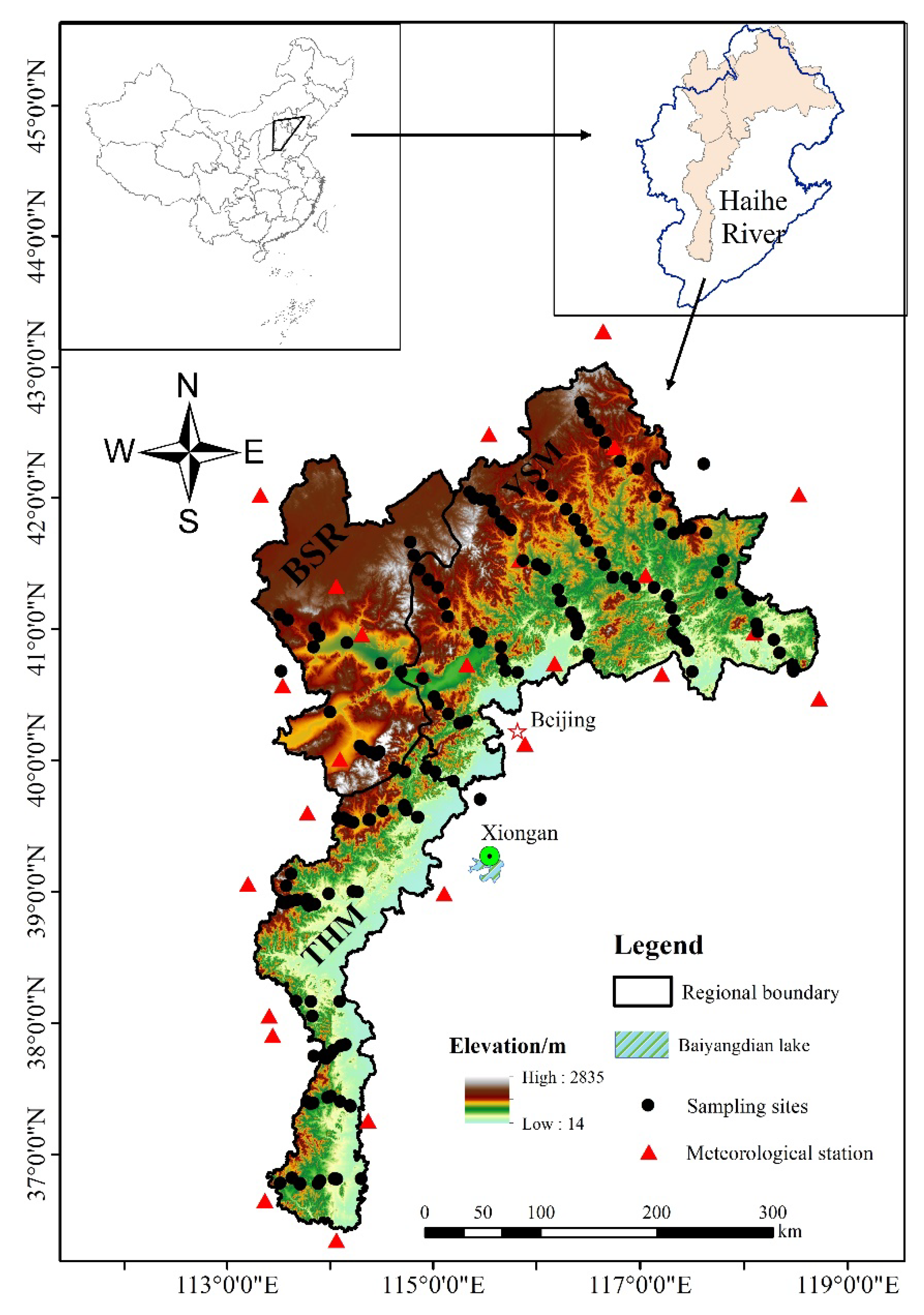
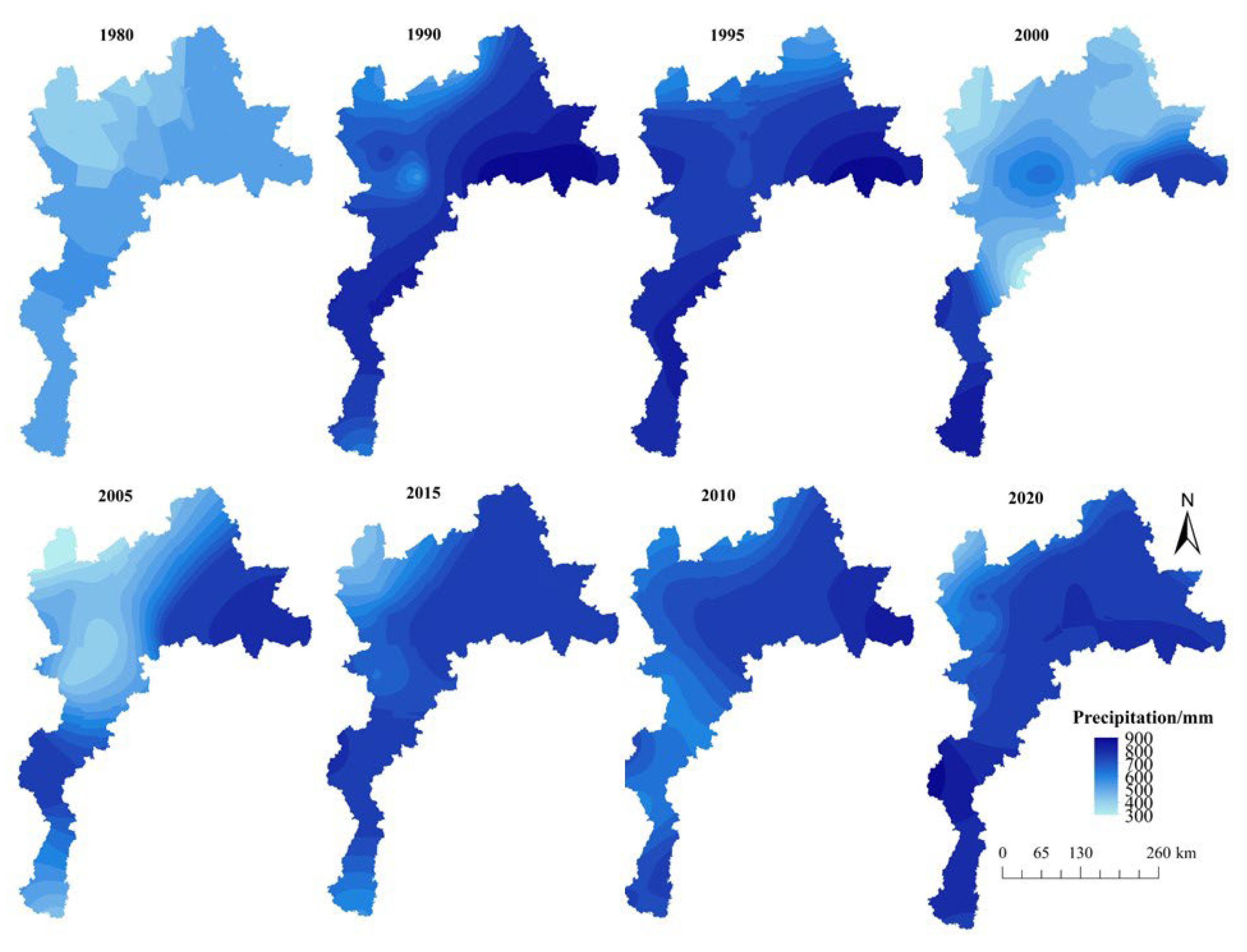
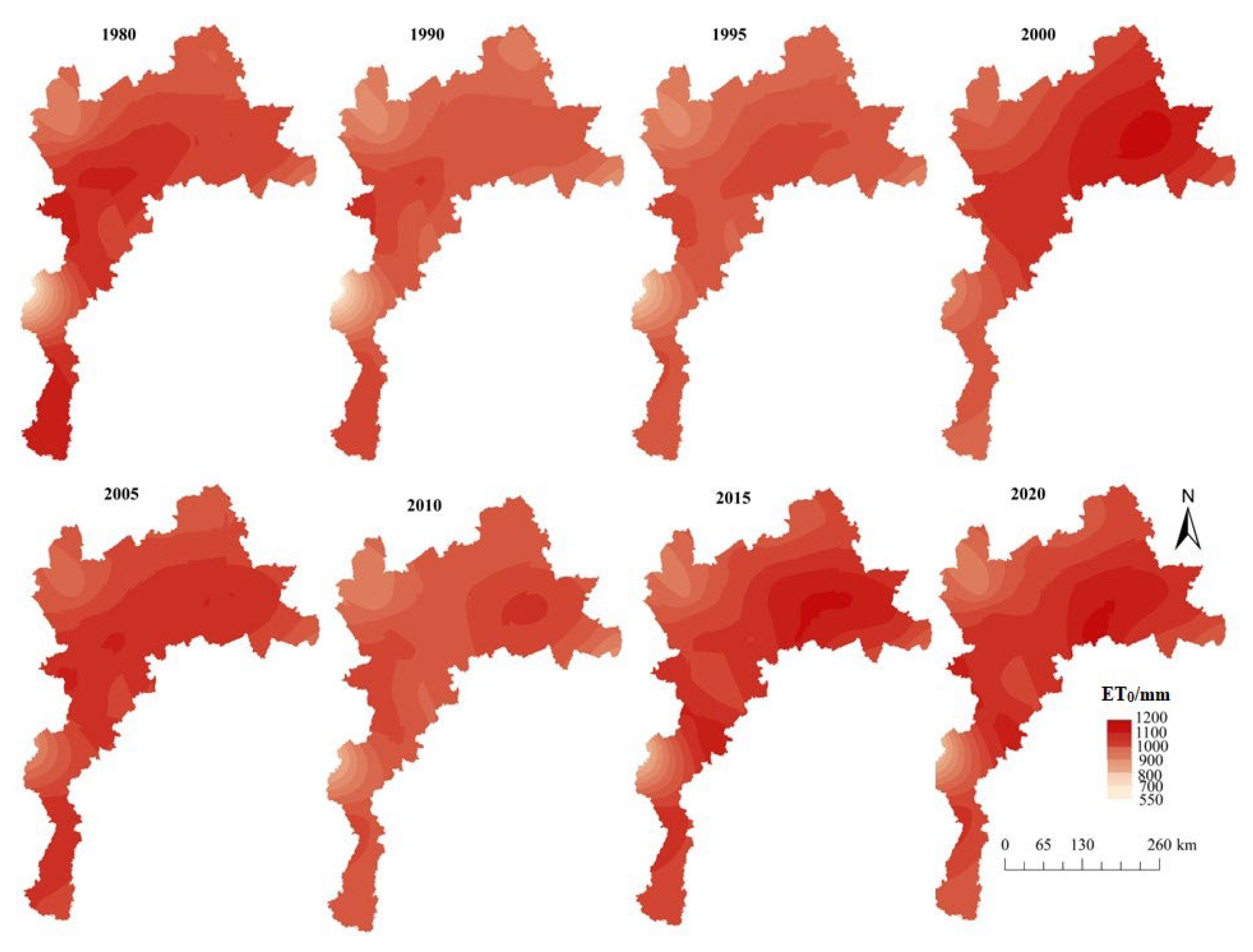
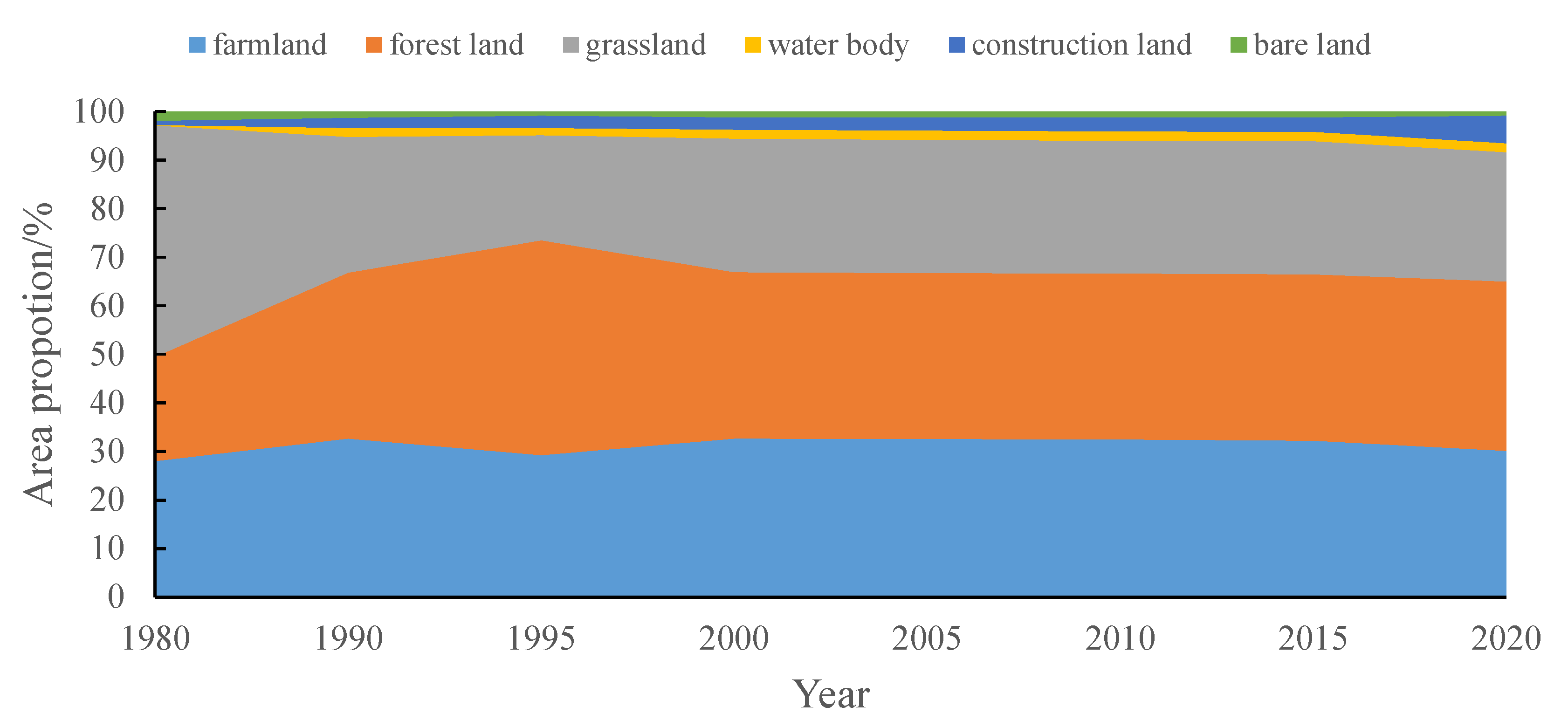
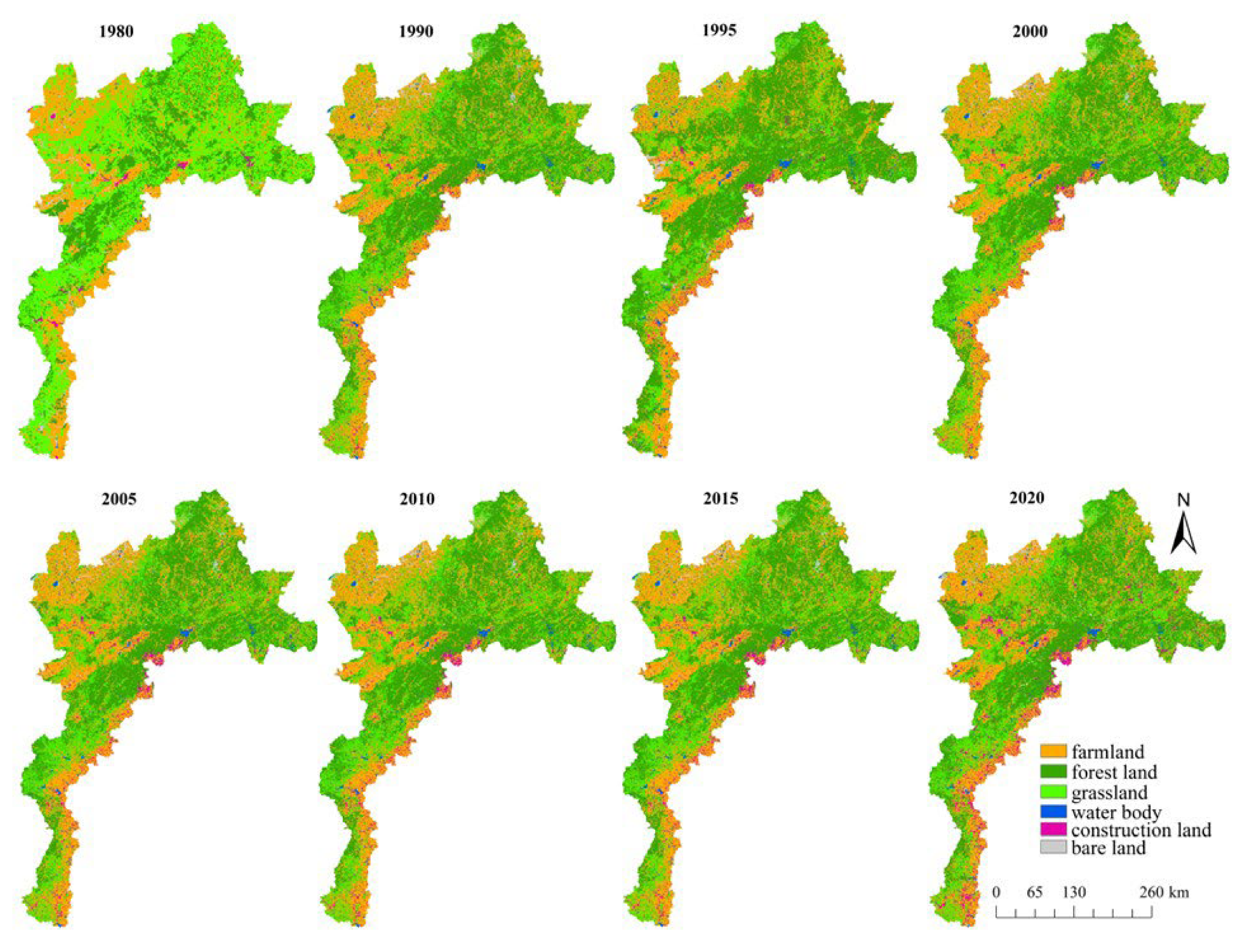
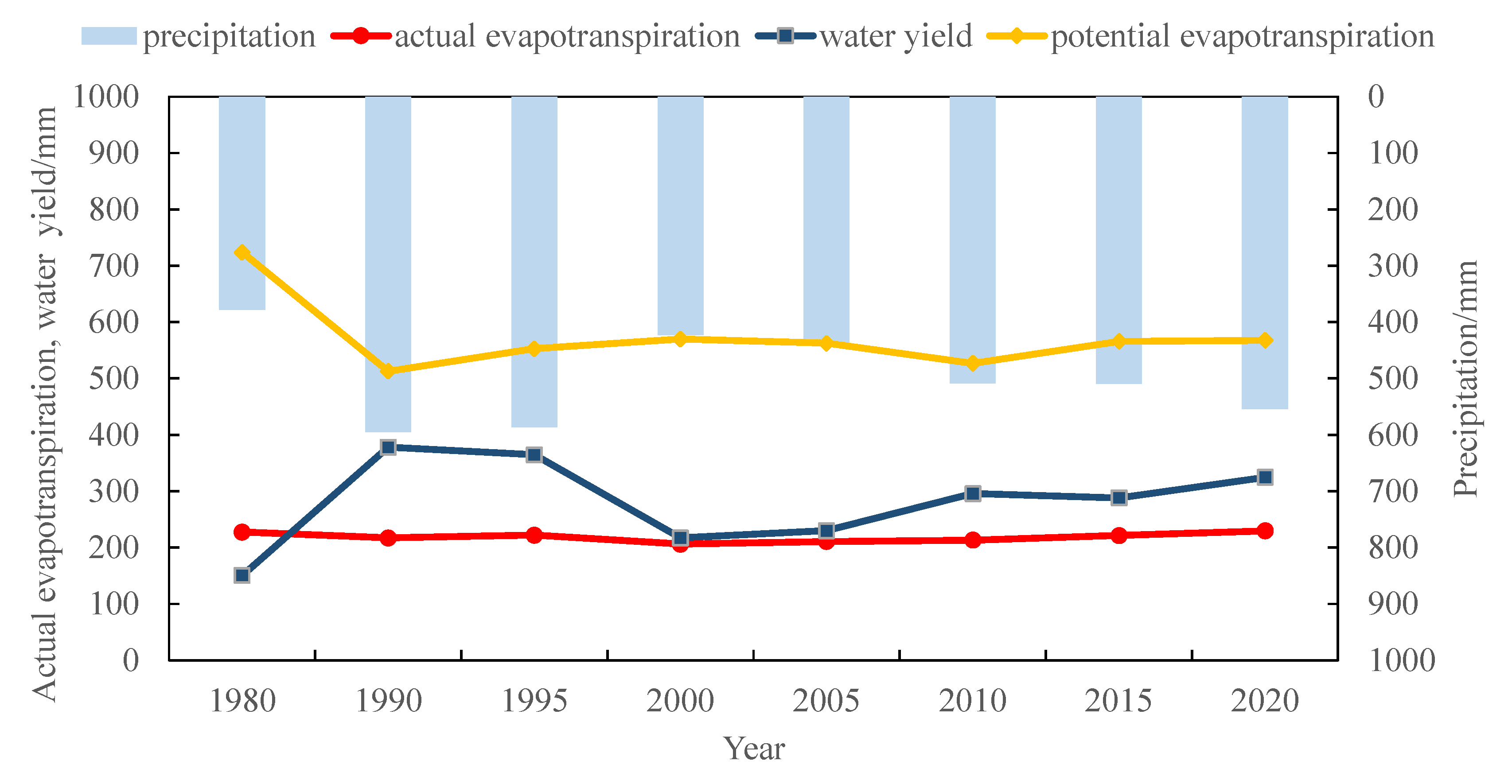

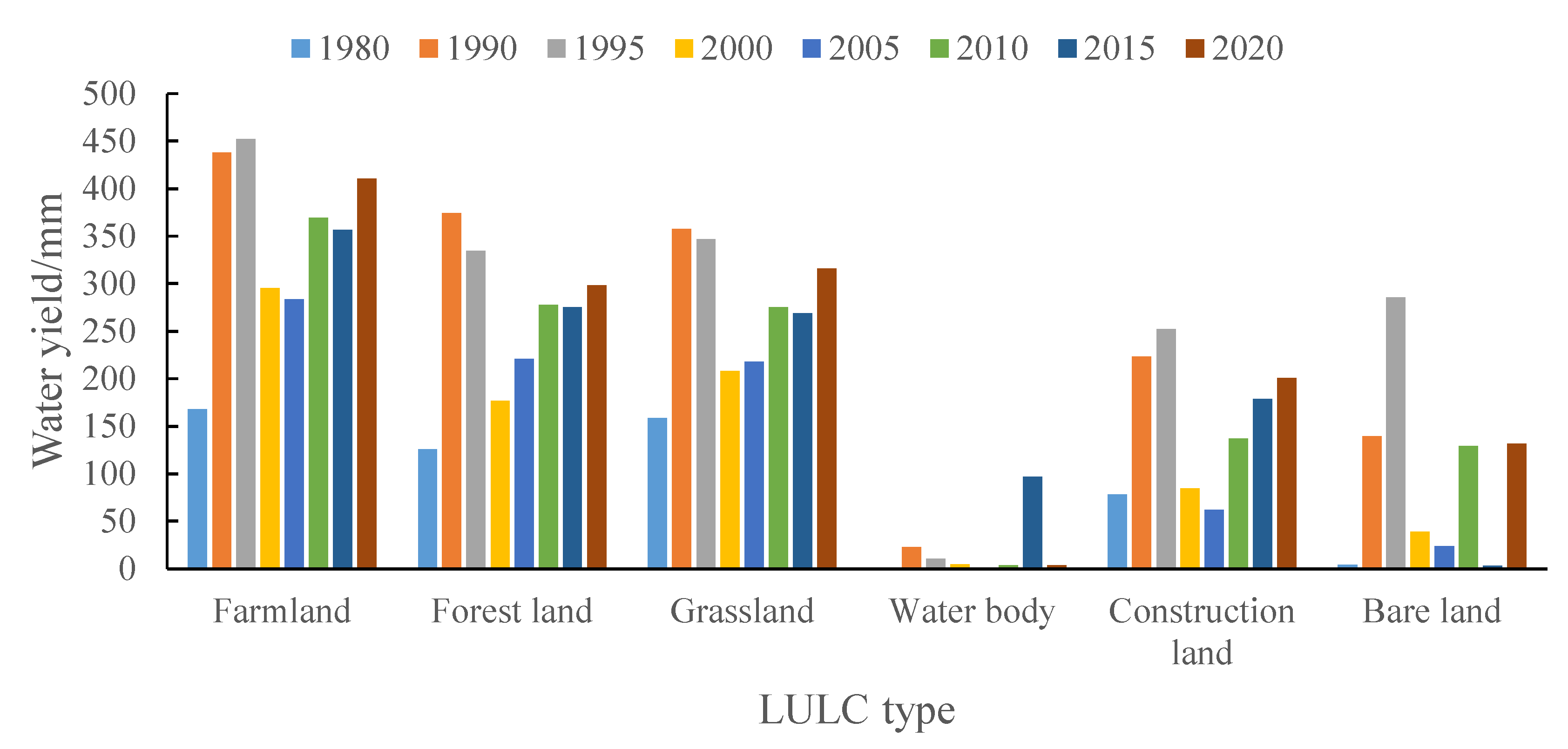
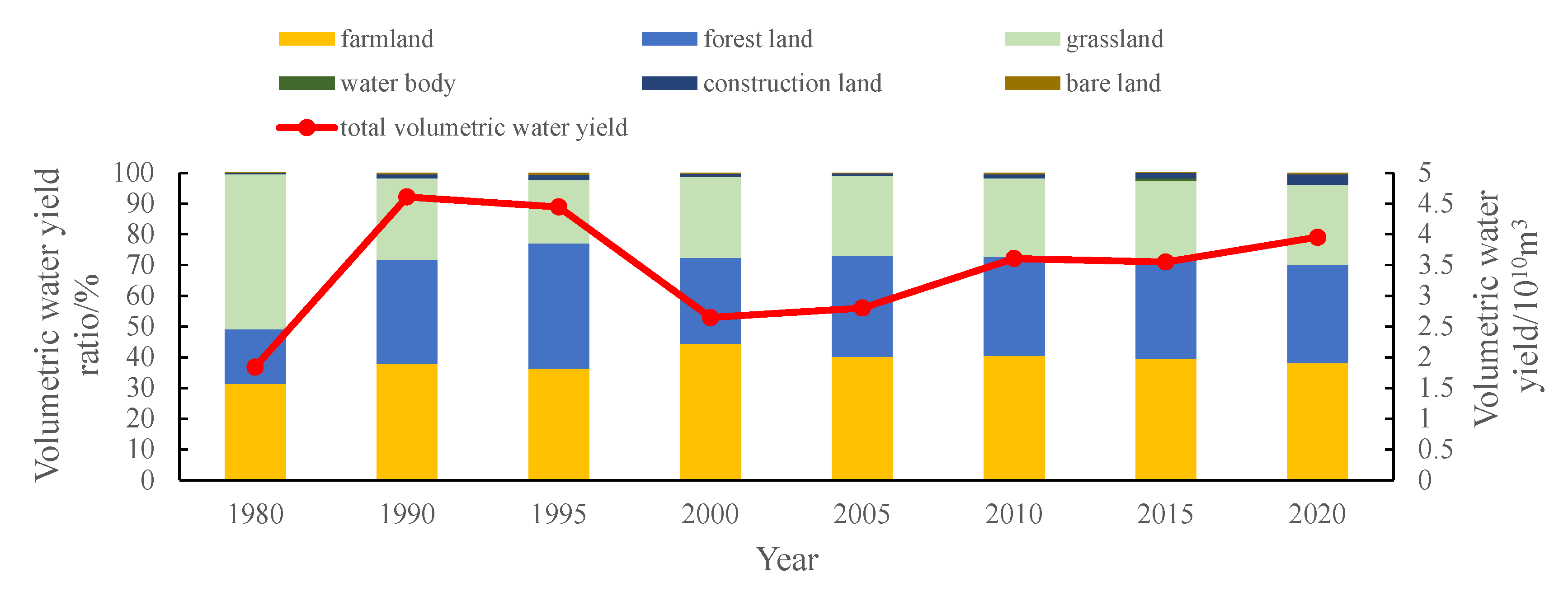
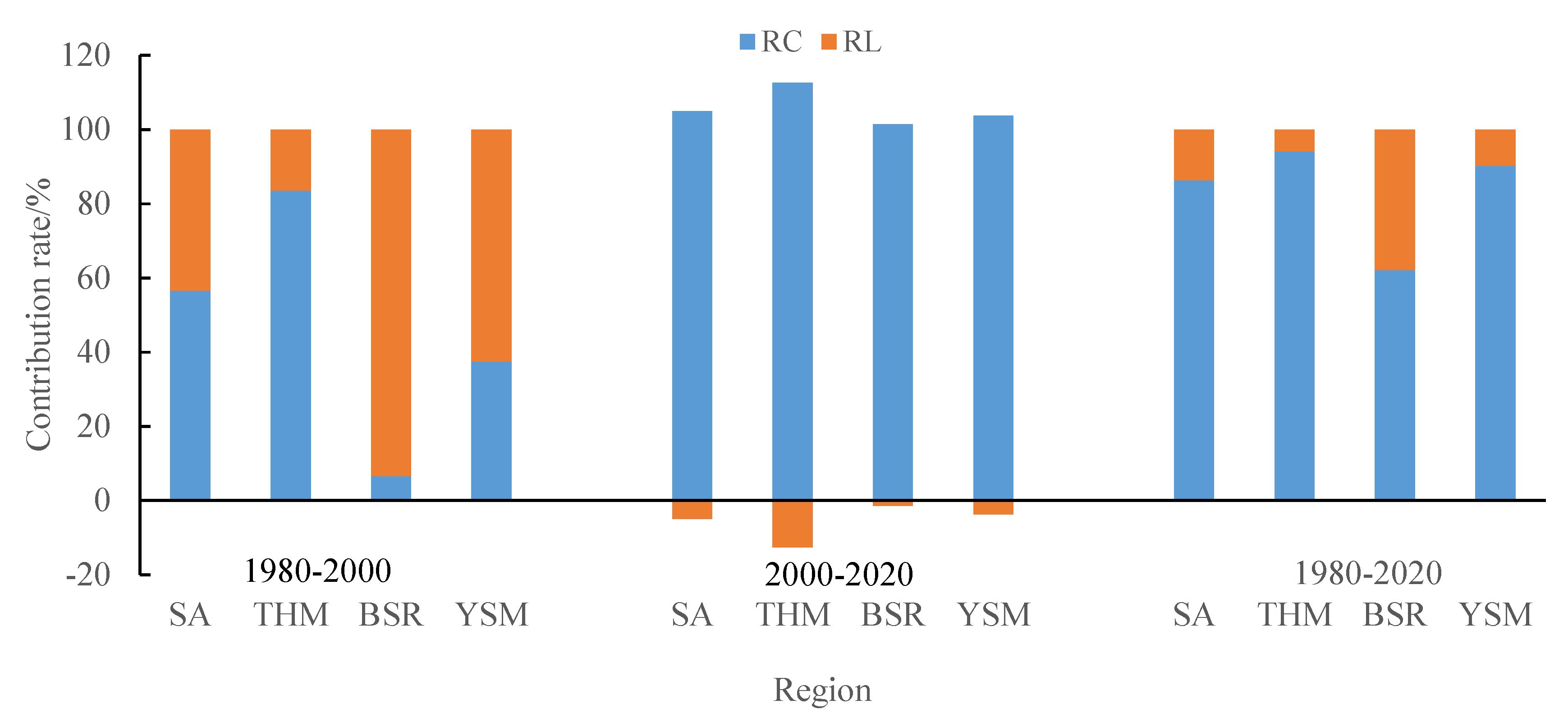
| Input | Description | Format/Units | Source |
|---|---|---|---|
| Precipitation | Average annual precipitation generated by the Kriging interpolation of daily precipitation data of 26 national meteorological stations (Figure 1) around the study area with Arc GIS 10.5 from 1980 to 2020 | GIS raster with a resolution of 100 m /mm | Daily precipitation data are downloaded from China Meteorological Data Network (http://data.cma.cn/) (accessed on 20 December 2022) |
| Reference evapotranspiration | Average annual reference evapotranspiration estimated based on the daily meteorological data of 26 national meteorological stations using the modified Hargreaves’ equation and generated the same as the precipitation data | GIS raster with a resolution of 100 m /mm | Daily meteorological data (including temperature, wind speed, sunshine duration, etc.) are downloaded from China Meteorological Data Network (http://data.cma.cn/) (accessed on 20 December 2022) |
| Root restricting layer depth | Soil depth at which root penetration is strongly inhibited, a conversion from soil depth data in feature format | GIS raster with a resolution of 100 m /mm | Soil depth data in feature format are extracted from the 1:1,000,000 Soil Database of China downloaded from the Nanjing Institute of Soil Science, Chinese Academy of Sciences (http://www.issas.cas.cn/) (accessed on 20 December 2022) |
| Plant available water content (PAWC) | Fraction of water that can be stored in the soil profile that is available for plants’ use. It is defined as the difference between the fraction of volumetric field capacity and permanent wilting point | GIS raster with a resolution of 100 m /mm | Calculated with SPAW software using soil texture data and content of soil organic matter obtained from 193 sampling sites collected in 2019 (Figure 1) |
| Land use/land cover (LULC) | Land use/land cover map in 1980, 1990, 1995, 2000, 2005, 2010, 2015, and 2020 | GIS raster with a resolution of 100 m | The Resources and Environmental Sciences Data Center (RESDC), Chinese Academy of Sciences (http://www.resdc.cn) (accessed on 20 December 2022) |
| Watersheds | Main watershed | GIS polygon | The study area boundary in this paper obtained according to administrative boundaries and contour data downloaded from China Meteorological Data Network (http://data.cma.cn/) (accessed on 20 December 2022) |
| Plant evapotranspiration coefficient | Plant evapotranspiration coefficient for each LULC class | Decimal in the range of 0 to 1.5 | FAO (http://www.fao.org) (accessed on 20 December 2022) |
| Biophysical table | Containing model information corresponding to each of the land use classes in the LULC raster (LULC class (Lucode), LULC_veg, root_depth and Kc) | .csv table | Lucode is the same as the land use raster map, LULC_veg is 1 for vegetated land use except wetlands, and 0 for all other land uses, root_depth is the value of root restricting layer depth, and Kc is plant evapotranspiration coefficient |
| Z parameter | Corresponding to the seasonal distribution of precipitation | Floating point value on the order of 1 to 30 | Calculated from the precipitation data |
| Factor | Real Condition | Climate Change Scenario | LULC Change Scenario | ||||||
|---|---|---|---|---|---|---|---|---|---|
| 1980 | 2000 | 2020 | S1 | S2 | S3 | S4 | S5 | S6 | |
| Climate | 1980 | 2000 | 2020 | 2000 | 2020 | 2020 | 1980 | 1980 | 2000 |
| LULC | 1980 | 2000 | 2020 | 1980 | 1980 | 2000 | 2000 | 2020 | 2020 |
| Year | Parameter | Regions * | ||
|---|---|---|---|---|
| THM | BSR | YSM | ||
| 1980 | Water yield (mm) | 179.44 | 131.61 | 145.81 |
| Ratio (%) | 39.28 | 28.81 | 31.91 | |
| 1990 | Water yield (mm) | 414.42 | 288.15 | 403.47 |
| Ratio (%) | 37.47 | 26.05 | 36.48 | |
| 1995 | Water yield (mm) | 449.41 | 326.64 | 343.82 |
| Ratio (%) | 40.13 | 29.17 | 30.70 | |
| 2000 | Water yield (mm) | 331.51 | 185.44 | 178.12 |
| Ratio (%) | 47.69 | 26.68 | 25.63 | |
| 2005 | Water yield (mm) | 251.86 | 163.30 | 251.98 |
| Ratio (%) | 37.75 | 24.48 | 37.77 | |
| 2010 | Water yield (mm) | 266.55 | 284.65 | 315.14 |
| Ratio (%) | 30.77 | 32.86 | 36.38 | |
| 2015 | Water yield (mm) | 305.26 | 251.71 | 298.04 |
| Ratio (%) | 35.70 | 29.44 | 34.86 | |
| 2020 | Water yield (mm) | 414.5 | 271.11 | 307.71 |
| Ratio (%) | 41.73 | 27.29 | 30.98 | |
Disclaimer/Publisher’s Note: The statements, opinions and data contained in all publications are solely those of the individual author(s) and contributor(s) and not of MDPI and/or the editor(s). MDPI and/or the editor(s) disclaim responsibility for any injury to people or property resulting from any ideas, methods, instructions or products referred to in the content. |
© 2023 by the authors. Licensee MDPI, Basel, Switzerland. This article is an open access article distributed under the terms and conditions of the Creative Commons Attribution (CC BY) license (https://creativecommons.org/licenses/by/4.0/).
Share and Cite
Yang, H.; Hou, X.; Cao, J. Identifying the Driving Impact Factors on Water Yield Service in Mountainous Areas of the Beijing-Tianjin-Hebei Region in China. Remote Sens. 2023, 15, 727. https://doi.org/10.3390/rs15030727
Yang H, Hou X, Cao J. Identifying the Driving Impact Factors on Water Yield Service in Mountainous Areas of the Beijing-Tianjin-Hebei Region in China. Remote Sensing. 2023; 15(3):727. https://doi.org/10.3390/rs15030727
Chicago/Turabian StyleYang, Hui, Xianglong Hou, and Jiansheng Cao. 2023. "Identifying the Driving Impact Factors on Water Yield Service in Mountainous Areas of the Beijing-Tianjin-Hebei Region in China" Remote Sensing 15, no. 3: 727. https://doi.org/10.3390/rs15030727
APA StyleYang, H., Hou, X., & Cao, J. (2023). Identifying the Driving Impact Factors on Water Yield Service in Mountainous Areas of the Beijing-Tianjin-Hebei Region in China. Remote Sensing, 15(3), 727. https://doi.org/10.3390/rs15030727






